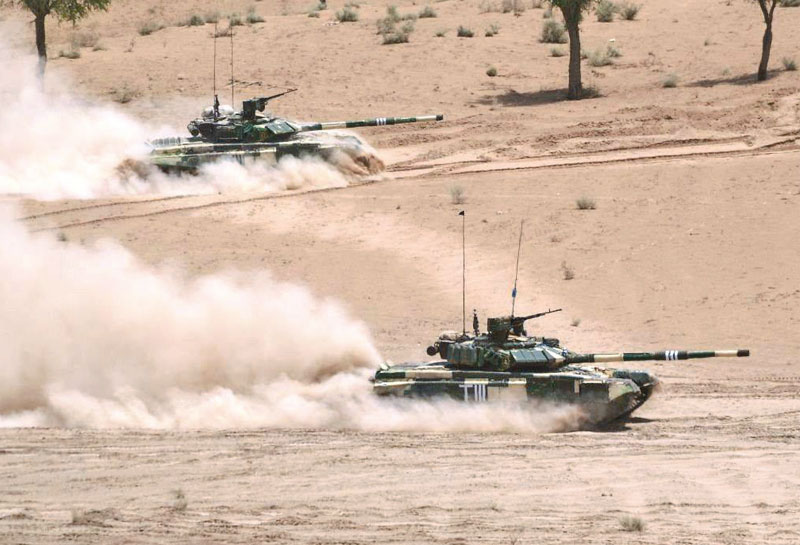The Indian Army needs light tanks in good numbers
Atul Chandra
The Indian Army has historically used light tanks such as the French AMX 13 and Russian PT-76 to great effect in wars of the past. Today, it operates a huge fleet of Main Battle Tanks (MBT) in its Russian-origin T-90 and T-72, with an authorised holding of 3,700 MBTs (though its actual numbers are much less). However, in the high-altitude and rarified air of the Himalayas, Indian armoured formations require a light tank that can be deployed quickly, adding to the firepower of troops on the ground.

The army’s present crop of MBTs also faces challenges associated with the elevation and depression of their main guns, which are insufficient for operations in high-altitude areas. As a result, the Indian Army will soon look to induct a third type of tank, that will add more firepower to its armoured formations in high-altitude areas.
The indigenously developed light tank is slated to have a combat weight not exceeding 25 tonnes and as a result, will be easier to transport by military transport aircraft. As compared to the new light tank, a T-72 MBT weighs 42 tonnes.
New Approach
By domestic standards, the development of the Zorawar light tank has progressed quickly and user trials with the Indian Army are planned to start in April, according to various media reports. The light tank is being developed by the Defence Research & Development Organisation (DRDO) in partnership with industry giant Larsen & Toubro (L&T). The present requirement is for 350 light tanks, though this number could increase in the future. An initial order for 59 light tanks has also been given, though series production examples could be manufactured by a company other than L&T.
Since the DRDO lab, Combat Vehicles Research & Development Establishment (CVRDE), has decades of experience with the Arjun MBT and L&T has been involved in the license production of the Hanwha K-9 Thunder Self-Propelled Gun (SPG), the development of the Zorawar light tank should ideally be completed on budget and on schedule.
The indigenously developed Zorawar light tank is being primarily developed for use in India’s Himalayan and North-Eastern frontiers. However, these two operational areas feature vastly different requirements. The former calls for operations in very high altitudes in extreme cold, while the latter calls for operations in jungle and riverine terrain with heavy rainfall and humidity. This makes the task of developing the light tank even more complicated.
Import Dependency
The programme has been impacted by Germany’s refusal to allow the supply of MTU powerpacks optimised for high-altitude operations. The Zorawar light tank is now to be powered by an engine sourced from the US firm Cummins. With its new 1,000 horsepower engine, the light tank will have a power to weight ratio of not less than 25:1 horsepower per tonne. Considering the Arjun MBT is also powered by an MTU engine, an indigenous alternative is being developed not only for this MBT but also for the Russian-origin MBTs in service.
In March, Bharat Earth Movers Limited (BEML) announced the maiden test run of India’s first indigenously made 1500 horsepower engine for MBTs. The project was initiated in August 2020. The first engine run of this 1500 horsepower powerplant signifies the completion of Generation One by BEML, focusing on technology stabilisation and under the next phase of the programme - Generation Two - BEML will produce engines for various trials at CVRDE. Following this, the new engines will be integrated into test vehicles for user testing, which is slated to be completed by mid-2025. The 1500 horsepower engine when fitted on the army’s current MBTs will deliver a high power-to-weight ratio and has been designed for operability in extreme conditions including high altitudes, sub-zero temperatures and desert environments.
The Zorawar light tank’s main weapon is thought to be the Cockerill 105 millimetre high pressure (HP) cannon supplied by John Cockerill Defence America. It is not known if the Indian version will come with the Cockerill’s 3105 turrets or be a customised variant. These turrets are integrated onto wheeled vehicles very similar to US Strykers. The turret offers a gun elevation capability of +42 degrees and also features a highly reliable autoloader. This main gun can fire all Nato (North Atlantic Treaty Organization) standard ammunition and requires a two-man crew for operation. In addition to the Zorawar light tank’s engine and main gun, much of its sensors could also be of foreign origin, albeit manufactured in India.
The Indian Army’s requirements for the new light tank are literally a quantum leap over its existing Russian-origin MBTs. The light tank is required to have multiple, modular and upgradeable weapon systems which will be capable of destroying multiple threats. It will be capable of destroying anti-aircraft threats and ground targets. The light tank will also feature a Remote Control Weapon Station (RCWS), carry smart weapons and have the ability to fire Anti-Tank Guided Missiles (ATGM) from its main gun. Countermeasure capability will also have to be provided.
It will also be fitted with Explosive Reactive Armour (ERA), Soft Kill Measures, Chemical Biological Radiological Nuclear (CBRN) Protection and Instant Fire Detection and Suppression System (IFDSS). All of the above requirements mean that the light programme is unlikely to be an inexpensive acquisition.
You must be logged in to view this content.

